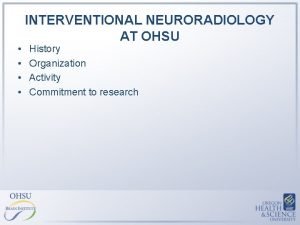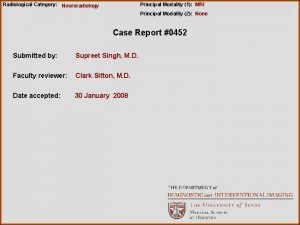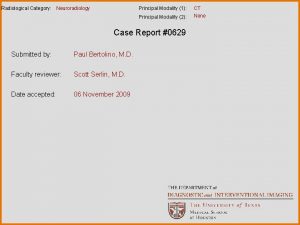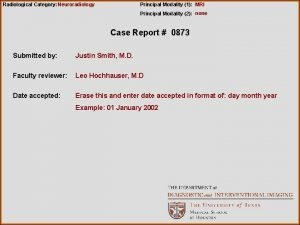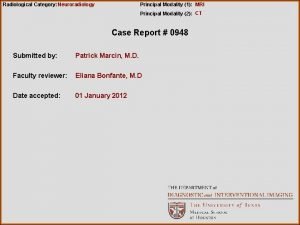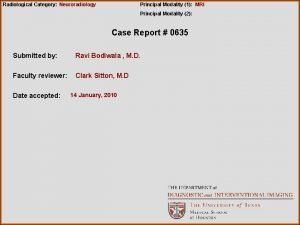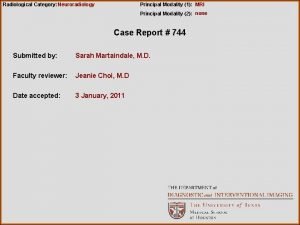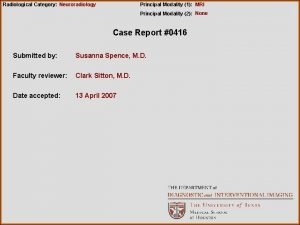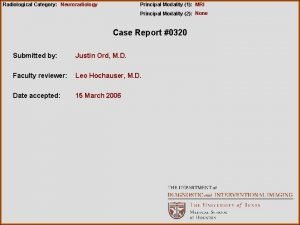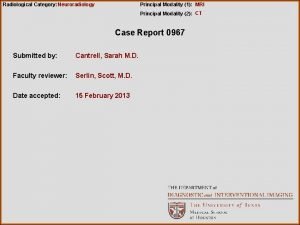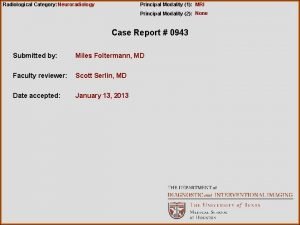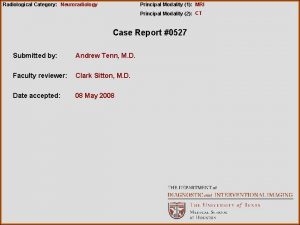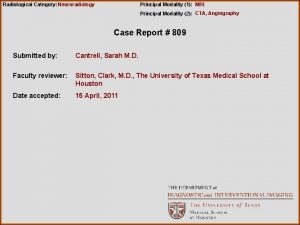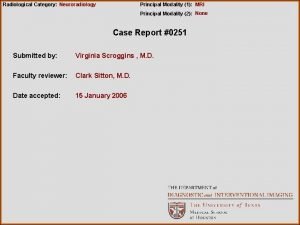Radiological Category Neuroradiology Principal Modality 1 MRI Principal















- Slides: 15

Radiological Category: Neuroradiology Principal Modality (1): MRI Principal Modality (2): None Case Report #0020 Submitted by: Michelle Miller-Thomas, M. D. Faculty reviewer: Leo Hochhauser, M. D. Date accepted: 10 November 2003

Case History A child was born with a mass protruding from the back of her head. She has been delayed in reaching developmental milestones. She presents at 7 months of age for repair of the mass.

Radiological Presentations Image #1 Mid-sagittal T 1 WI

Radiological Presentations Image #2 Mid-sagittal T 2 WI

Radiological Presentations F Image #3 Axial T 1 WI Occipital bone Cerebral gray and white matter Dura and skin

Radiological Presentations F Frontal horn left lateral ventricle Image #4 Axial T 1 WI Temporal horn left lateral ventricle

Radiological Presentations Image #5 Para-sagittal T 1 WI

Radiological Presentations Image #6 MRV

Test Your Diagnosis Which one of the following is your choice for the appropriate diagnosis? After your selection, go to next page. • Dandy-Walker malformation • Meningocele • Encephalocele • Hydrocephalus • Dermoid

Findings and Differentials Findings: • A sac protrudes from the midline through a defect in the occipital bone containing septated fluid collections, meninges, cerebral gray and white matter, and vessels. • There is hydrocephalus with enlargement of the left lateral ventricle. • MRV shows venous sinuses in the sac. Differential: • Encephalocele • Meningocele • Dermoid

Discussion Encephaloceles are congenital herniations of brain and/or meninges through a defect in the skull. Such a defect may be located along the skull base or at the cranial vault at points of incomplete or defective fusion. They represent congenital malformations of the calvarium and dura with extracranial herniation of meninges, brain, ventricles, choroid plexus, vascular structures and cerebrospinal fluid. Congenital encephaloceles arise from failure of the neuropore to fuse in the fourth week of development. Acquired encephaloceles are also seen after trauma or surgery involving the cranium, however the remainder of this discussion will focus on the congenital encephaloceles. The overall incidence of encephaloceles is approximately 0. 8 to 3. 0 per 10, 000 live births and account for 10 to 20% of all cases of craniospinal dysraphism. Occipital encephaloceles are the most common type in North America and western Europe comprising 66 to 89% of the cases. Anterior encephaloceles are more common in Southeast Asia, parts of Russia, and central Africa. 70% of occipital encephaloceles occur in females. Encephaloceles can develop along any of the cranial sutures of the cranial vault, the facial bones and along the bones of the skull base. They can vary greatly in size from a small, barely noticeable bulge to a structure larger than the patient’s skull. Large encephaloceles may contain a majority of the total brain mass. Encephaloceles at the skull base may remain hidden from view.

Discussion Small encephaloceles may represent pinched off brain tissue which involutes or atrophies resulting only in a nodule of gliotic tissue. A "nasal glioma" represents such a condition where the brain herniates through a defect in the ethmoid bone and protrudes into the nasal cavity where a biopsy usually reveals glial tissue. Anterior encephaloceles often present as bulges of varying size around the patient’s nose or orbits. Cranial meningoceles involve herniation of meninges and CSF only. Patients with small defects may be neurologically normal. Larger masses may be associated with neurologic deficits, such as developmental delay, poor feeding, cranial nerve abnormalities, spasticity, and blindness. The sac is usually covered in skin, however the sac can develop ulcerations. Patients with large sacs may have microcrania. Associated neural tube defects can be seen in 15 to 20% of patients. Hydrocephalus occurs in 20 to 65% of cases and is due to herniating structures obstructing CSF flow. Associated congenital malformations can include micrognathia, clinodactyly, web neck, thyroglossal cyst, and hypoplastic cranium. Encephaloceles are associated with several syndromes including defects in brain development, facial development, abdominal organs, and the appendicular skeleton.

Discussion Early detection of encephaloceles may be achieved by prenatal ultrasonography as early as 12 weeks of gestation. CT and MRI are the mainstays of encephalocele imaging after the birth of the child. Vaginal delivery is contraindicated with large encephaloceles. MRI in the sagittal projection using T 1 and/or T 2 -weighted imaging defines the contents of the herniated sac and can identify other associated brain anomalies such as dysgenesis of the vermis, dysplasia of the corpus callosum and aqueductal stenosis with resulting hydrocephalus. Imaging of the vascular structures, especially the dural venous sinuses, with MRV techniques is important to surgical planning. CT will best define the bony distortions in anterior encephaloceles and guide the surgeon when craniofacial reconstruction becomes necessary. Surgical repair of encephaloceles is an elective procedure unless there is rupture of the sac with leakage of CSF. If the sac contains nonfunctional, fibrous, or gliotic tissue the mass can be transected flush with the skull. If the surgeon wants to preserve the tissue contained in the sac, then an expansion procedure can be performed. One technique slowly pushes the contents of the sac into the cranium over a period of weeks to months, causing expansion of the skull. Another technique takes advantage of existing expansion of the skull due to associated hydrocephalus. The surgeon places a ventriculoperitoneal shunt to decompress the ventricles and allows the herniated contents to move back into the cranium. Small cranial defects may not require closure with bone, while large defects require closure with autologous bone graft or synthetic material. The facial deformities caused by anterior encephaloceles are usually handled by a craniofacial surgeon usually in the same sitting with the neurosurgeon.

References Albright et al, Principles and Practice of Pediatric Neurosurgery, 1999 Thieme, New York. Chapter 10 – Encephaloceles, Meningoceles, and Dermal Sinuses. William S. Ball, Jr. , Pediatric Neuroradiology, 1997 Lippincott Raven, Philadelphia. Chapter 5 – Congenital Malformations of the Brain. Moore et al, The Developing Human: Clinically Oriented Embryology 5 th Edition, 1993 W. B. Saunders Company, Philadelphia. Chapter 18 – The Nervous System.

Diagnosis Occipital encephalocele Hydrocephalus
 Ohsu neuroradiology
Ohsu neuroradiology Erate category 2 eligible equipment
Erate category 2 eligible equipment Radiological dispersal device
Radiological dispersal device Tennessee division of radiological health
Tennessee division of radiological health Center for devices and radiological health
Center for devices and radiological health National radiological emergency preparedness conference
National radiological emergency preparedness conference Mri principal
Mri principal Sensory vs somatic
Sensory vs somatic Modality
Modality Swd modality
Swd modality Modality microsoft services
Modality microsoft services Sodality vs modality
Sodality vs modality Cardinality and modality
Cardinality and modality Crow's foot notation
Crow's foot notation Epistemic modality
Epistemic modality Cardinality and modality
Cardinality and modality
